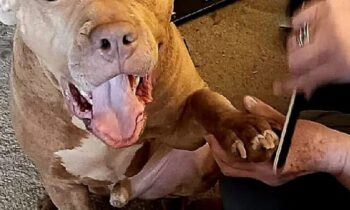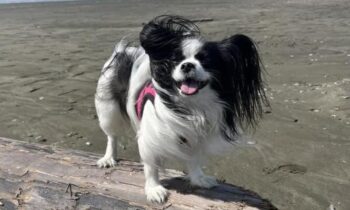

Q: I am looking for some guidance on a little fellow I am fostering for my local animal shelter. He is probably in the Yorkshire terrier family, possibly purebred. He weighs eight pounds and he’s around ten years of age, as estimated by shelter staff. He came in as a stray with both eyes so infected they had to be removed immediately. That surgery was done two days ago. Shelter staff thinks that he may have been used in a puppy-mill situation because he has never been neutered.
He is a sweetie but, of course, insecure, confused, and lost. He is following my voice well. I think his eyesight may have been limited for some time.
How do I help him adjust to blindness? Any suggestions or links for reading on how best to get him acclimated would be great. What tricks are there?
A: Use the senses he does have—hearing, smell, and touch.
Sound Cues
▪ Attach a small jingle bell to your shoe to help him follow your movement.
Make the bell easy to attach to and detach from your footwear with some sort of simple clip. (Buy duplicate bells from day one, assuming you’re going to misplace some. You will!)
More than one person in your household? You can probably find a variety of small bells with different sounds, or you can simply give everybody the same style of bell. Maybe the dog will perceive a different sound from each one that we humans can’t, or maybe the sound of the bell will simply mean “friendly human” to him.
He’ll be using other sound cues, like your footsteps on the floor, that may help him differentiate among family members and caregivers, along with each individual’s own “scent cues,” so the bells on your shoes won’t be the only information he’s receiving.
▪ Teach coming when called with a sound, like a squeak toy or whistle.
This particular dog was a stray, so his past experience is unknown. His foster family will have to make their best guesses about his background based on what they see of him now. They can’t know, for example, what sounds might please him, what sounds might scare him. They must experiment. Even then, they’ll never know why he reacts the way he does—they can only guess.
Experiment with various sounds that you might use for a recall—coming when called immediately and fast. I suggest starting with what you have at home already, like dog squeaky toys. Look for a sound-maker that is easy to carry around, in a pocket or on a cord around your neck. You’ll want one for each adult in the family, for each of the dog’s caregivers, more to hang by the doors to outside, just in case . . . plus extras so you have lots of the same item.
Whistles are a possibility, if the dog doesn’t seem frightened of that sort of sound. I’ve found local sports and camping-gear stores to be a great source for whistles and whistle-like noisemakers, although some of those devices are not inexpensive. Don’t spend a fortune! Ask the staff; find a salesperson who might enjoy helping you fill a somewhat unusual need. Don’t take the dog on the shopping expedition, but do make sure any mouth-powered item you purchase is returnable if the dog does not respond well to it when you get it home.
Party supply stores are another potential source of inexpensive items that make noise. Again, do not take the dog with you on the shopping trip, and do make sure the items are returnable if the dog runs from the noise when you try it out at home. Once you settle on a good sound, buy multiples of the item (ideally something that’s always going to be in stock when you need more).
Do not use a clicker as a sound cue to recall your dog.
Clickers have a much higher purpose—not for recalls!

Photo by Val Hughes
Scent Cues
▪ Use scent to mark doorways, top/bottom of stairs, entrances/exits.
It’s unlikely that even a ten-year-old dog will have adverse reactions to particular smells, but you never know!
You probably have vanilla extract in your baking-supply cupboard, so that’s an easy one to test. Put a tiny dab of it on a tissue or on a cotton swab, move it through the air a few feet away from the dog, see what happens. No reaction? That’s fine. Interest shown by sniffing? That’s okay, too. Sneezing? Too much scent perhaps? Dog takes one whiff and runs away? Might not work!
Read up on what scents, in what form, are safe for dogs.
Figure what you want to “mark” with scent first, and try it.
For the dog, the process of learning what the scent means is a matter of repeating the experience again and again. For example, scent on frame of door to back yard. Dog smells the scent, dog goes outside, dog is rewarded by the relief of eliminating. Eventually, the scent should say to the dog, “Dog potty this way!”
You may choose to mark the top and bottom of stairs with scent, but please remember that physical barriers should be in place when you are not right next to the dog supervising his climbing up or down those stairs. Baby gates are mandatory for a blind dog in a new atmosphere. Don’t take chances!
Location Cues
Sherry Al-Mufti shared her experience with a blind dog:
I had a boarding client whose dog had gone blind. They carried him everywhere. I encouraged him to walk on his own and initially guided him by clapping my hands a few feet in front of him and encouraging him with my voice.
It was a joy to see him beginning to gain confidence, [as he learned] to navigate on his own, which he did surprisingly quickly. After a few weeks, he could find his way through the door to outside and back again without help from me.
Eventually, he [became] very skilled at navigating various hazards, such as doggie excavation projects, in the yard he used. One day, I saw him heading for a rather deep hole, and I tried to redirect him before he stumbled. Hah!
“I got this!” he said.
He walked down into the hole and back up out of it without missing a beat.
One important thing to keep in mind is not to move furniture and other objects so the environment stays consistent, especially while the pup is gaining confidence.
It’s as important with blind dogs as it is with real estate: location, location, location. The most commonly given advice about dogs with no or low vision? Don’t move the furniture!
This is especially true if the dog has lived in that particular place for a while. When sight is lost overnight, the dog will rely on his instinctive “memory” of the map of his home and its surroundings. He will stick with his habitual “paths” and navigate without much effort. Close a door that’s always been open and he may well bump into it. That could make him less confident.
In this foster dog’s case, he’s in a new place where he’s never been before, being cared for by strangers. He has no “memory map” of his foster home and no knowledge whatsoever about his foster family. He’s being confined in a small area to start, and taken outside to potty—which he is doing successfully, his foster “mother” reports! He’s small, so he could be carried, assuming he was comfortable with that.
He’s also showing that he can be encouraged by the human voice, and his foster home has an easily accessible fenced yard, so there’s no need for a leash.
Leashing a bigger dog would probably be advisable, even inside the house, both for the physical cues the leash can give the dog and, most important, for the dog’s safety and the human’s safety. In a foster situation, you have the complication of needing to know from day one what sort of reaction the dog has to being leashed. Ideally, that would be discovered before the foster took the dog home!
For a dog that will go from sighted to blind through a planned surgery, I suggest that the dog’s human family experiment with a harness for the dog before the surgery, if the dog has never worn a harness. If surgery is a few weeks—even a few days—away and the dog is healthy otherwise, taking the time before the surgery to accustom the dog to wearing a harness might be doing him or her a huge favor. The harness may be a better way than a collar and leash to walk the dog comfortably once it is blind.
Physical Cues
Assistive devices for blind dogs do exist!
“A blind dog needs something to tell him that he is approaching an obstacle. Blind people use a walking stick, other animals that are naturally blind use sound, whiskers, or some other form of early warning device. This hoop is a blind dog’s ‘walking stick.’” —handicappedpets.com
The hoop or “halo” is a half-circle of plastic or aluminum, attached to a harness. The “hoop” extends out in front of the dog so that, when the dog is going forward, the hoop touches any obstacle before the dog bumps into it, so the dog can move away. These devices can be purchased or home made.
Here is a link to directions for making your own hoop device:
https://www.handicappedpets.com/blind-dog-hoop-harness
Search “How To Make A Blind Dog Halo” for more videos.
How do you train all the new behaviors a dog needs to learn when it is suddenly blind? Luckily for all concerned, the basics of good training are the same, whether the dog can see or not.
Reward the behavior you want.
The dog follows the sound of your voice. What will reward him best? Try cooked chicken chunks . . . smelly, soft, easy to swallow. (Don’t overdo it, if he’s just had surgery.)
The dog will show his foster family what he likes as they get to know him better.
I’m hoping we’ll hear good news about his recovery and potential for adoption!
Here are a few of the resources available for information about blind dogs:
Living With Blind Dogs: A Resource Book and Training Guide for the Owners of Blind and Low-Vision Dogs, by Caroline D. Levin, RN
https://www.handicappedpets.com/blind-dogs-advice-a-products-to-help-them/
https://www.blinddogrescue.org/dog-blindness/tips-for-owners/
https://www.petfinder.com/dogs/dog-care/living-with-blind-dogs/



